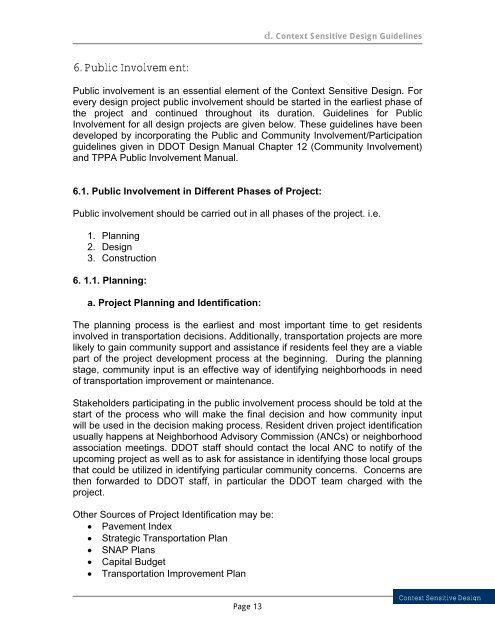Context Sensitive Design Guidelines - sacog
Context Sensitive Design Guidelines - sacog
Context Sensitive Design Guidelines - sacog
You also want an ePaper? Increase the reach of your titles
YUMPU automatically turns print PDFs into web optimized ePapers that Google loves.
d. <strong>Context</strong> <strong>Sensitive</strong> <strong>Design</strong> <strong>Guidelines</strong><br />
6. Public Involvement:<br />
Public involvement is an essential element of the <strong>Context</strong> <strong>Sensitive</strong> <strong>Design</strong>. For<br />
every design project public involvement should be started in the earliest phase of<br />
the project and continued throughout its duration. <strong>Guidelines</strong> for Public<br />
Involvement for all design projects are given below. These guidelines have been<br />
developed by incorporating the Public and Community Involvement/Participation<br />
guidelines given in DDOT <strong>Design</strong> Manual Chapter 12 (Community Involvement)<br />
and TPPA Public Involvement Manual.<br />
6.1. Public Involvement in Different Phases of Project:<br />
Public involvement should be carried out in all phases of the project. i.e.<br />
1. Planning<br />
2. <strong>Design</strong><br />
3. Construction<br />
6. 1.1. Planning:<br />
a. Project Planning and Identification:<br />
The planning process is the earliest and most important time to get residents<br />
involved in transportation decisions. Additionally, transportation projects are more<br />
likely to gain community support and assistance if residents feel they are a viable<br />
part of the project development process at the beginning. During the planning<br />
stage, community input is an effective way of identifying neighborhoods in need<br />
of transportation improvement or maintenance.<br />
Stakeholders participating in the public involvement process should be told at the<br />
start of the process who will make the final decision and how community input<br />
will be used in the decision making process. Resident driven project identification<br />
usually happens at Neighborhood Advisory Commission (ANCs) or neighborhood<br />
association meetings. DDOT staff should contact the local ANC to notify of the<br />
upcoming project as well as to ask for assistance in identifying those local groups<br />
that could be utilized in identifying particular community concerns. Concerns are<br />
then forwarded to DDOT staff, in particular the DDOT team charged with the<br />
project.<br />
Other Sources of Project Identification may be:<br />
• Pavement Index<br />
• Strategic Transportation Plan<br />
• SNAP Plans<br />
• Capital Budget<br />
• Transportation Improvement Plan<br />
Page 13<br />
<strong>Context</strong> <strong>Sensitive</strong> <strong>Design</strong>
















